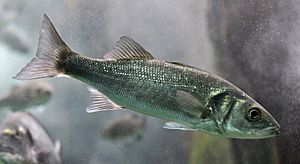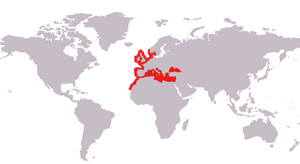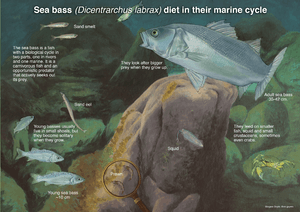European seabass facts for kids
The European seabass (Dicentrarchus labrax) is a cool fish found mostly in the waters off Europe and North Africa. You can also find it in shallow coastal areas and river mouths, especially in summer and late autumn. It's one of only six types of fish in its family, called the temperate basses.
This fish is super important for fishing and farming, especially in the Mediterranean Sea. If you order "sea bass" in a restaurant in places like Ireland or the UK, it's usually this European seabass! In North America, it's often called "branzino."
European seabass grow slowly and take a few years to become adults. A grown-up European seabass usually weighs about 2.5 kg (5.5 lb). They can grow up to 1 meter (3 ft 3 in) long and weigh 12 kg (26 lb), but most are about half that size, around 0.5 meters (1 ft 8 in). They have shiny silver-grey bodies, and sometimes their backs look dark blue.
Young seabass like to swim together in groups and eat small creatures without backbones, like tiny crabs. Older seabass are more independent and prefer to hunt other fish. They often hang out near riverbanks, lagoons, and estuaries in the summer. When winter comes, they move further out into the sea. They love to munch on prawns, crabs, and small fish. Even though many people like to fish for them, the European seabass is not considered endangered. This is because there are lots of them, and no big threats are known.
Quick facts for kids European seabass |
|
|---|---|
 |
|
| Conservation status | |
| Scientific classification | |
 |
|
| Distribution of European seabass |
Contents
About the European Seabass Name
The European seabass got its first scientific name in 1758 from a Swedish scientist named Carl Linnaeus. He called it Perca labrax. Over time, scientists gave it many different names, but Dicentrarchus labrax became the official one in 1987.
This fish has lots of common names depending on where you are! In the British Isles, people call it "European bass," "sea bass," "common bass," or even "white salmon."
Scientists have found that there are two main groups of wild European seabass that are a bit different from each other. One group lives in the northeast Atlantic Ocean, and the other lives in the western Mediterranean Sea. These two groups are separated by a small area near the Spanish city of Almería. It's a bit of a mystery why they don't mix more, even though young seabass can drift with currents and adults can travel long distances.
Where They Live
European seabass can live in many different places, like river mouths, lagoons (shallow bodies of water separated from the sea), coastal waters, and even rivers. You can find them in a big part of the eastern Atlantic Ocean, all the way from southern Norway down to Senegal. They also live throughout the entire Mediterranean Sea and in the southern Black Sea. However, you won't find them in the Baltic Sea.
These fish move around with the seasons. They travel to special places to lay their eggs in winter, and then they move to different areas to find food in the summer.
What They Eat and How They Behave
The European seabass hunts for food both during the day and at night. They eat small fish, worms, squid, and crabs. Bigger seabass, especially those weighing more than 4 kg (8.8 lb), usually hunt more at night.
They lay their eggs from February to June, mostly in waters close to the shore. When they are very young, they float freely in the water. But as they grow, they move into river mouths and stay there for a year or two before heading out to sea.
Fishing and Farming European Seabass
Catching Wild Seabass
People catch a fair amount of wild European seabass each year, usually between 8,500 and 11,900 tonnes. Most of these fish are caught in the Atlantic Ocean, with France often catching the most. In the Mediterranean, Egypt now catches more than Italy used to.
Because so many people want to catch this fish, there's been a lot of pressure on their numbers. In the United Kingdom, people who fish for fun have started a movement to help protect them. Ireland has strict rules about catching bass. It's against the law to fish for them for money, and there are rules for people who fish for fun:
- You can't fish for them from May 15 to June 15.
- The fish must be at least 400 mm (15.7 in) long.
- You can only keep two fish per day.
Scientists have noticed that the number of seabass has been going down since 2005.
Farming Seabass
The European seabass was one of the first fish to be farmed in Europe. In the past, they were raised in coastal lagoons. But in the late 1960s, new ways to farm them on a large scale were developed. Now, it's the most important fish farmed in the Mediterranean. Countries like Greece, Turkey, Italy, Spain, Croatia, and Egypt are the biggest farmers. In 2010, over 120,000 tonnes of European seabass were produced! Turkey is currently the biggest producer of European seabass in the world.
Images for kids
See also
 In Spanish: Lubina para niños
In Spanish: Lubina para niños







